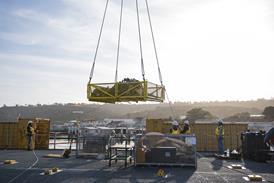Tim Furniss/LONDON

The European Space Agency (ESA) will make history in 2012 when its 100kg Rosetta makes the first soft landing of a spacecraft on a comet.
The Rosetta mission launch is due in January 2003, but solar orbit mechanics mean the first rendezvous with the comet Wirtanen will not happen until 2011. Rosetta will also make the first orbit of a comet and deposit its lander craft onto the surface as Wirtanen approaches the sun and begins to shed material, forming a tail.
Scientists believe Rosetta will give a better understanding of the birth and evolution of the planets and life on Earth.
Many comets are far larger than Wirtanen, which is just 1km wide, but as it orbits the sun every five-and-a-half years it is easier to reach than most comets and its path is predictable. Since its discovery in 1948, Wirtanen has been well-observed and has a familiar orbit.
Because of its multiple approaches to the sun, Wirtanen has also lost most of its volatile gases, so outgassing remains quite low. This will make it easier for the instruments on the orbiter and lander to take images of and study the comet's surface. By comparison, the spacecraft Giotto's 1986 exploration of Halley during a high-speed fly-by was like trying to see in a dust storm.
Rosetta cannot simply be launched at Wirtanen at its closest approach to the sun in 2012. Orbital mechanics and other mission objectives dictate a 10-year flight, which will include a rendezvous with two asteroids. Rosetta will also have to fly alongside Wirtenan for more than a year, matching its speed, before entering orbit around it.
Rosetta, the third Cornerstone mission in ESA's Horizon 2000 long-term science programme, will be launched by an Ariane 5 from French Guiana in January, 2003. Rosetta will rendezvous with Wirtanen in November 2011, at 675 million km from the sun.
Once the navigation team at Germany's Darmstadt control centre determines the comet's exact location from images returned from the spacecraft's camera, a series of braking manoeuvres will allow Rosetta to match speed and direction with its target. By May 2012, Rosetta will eventually have come to within 2km of Wirtanen's still-frozen nucleus and will enter orbit around it.
Roger Bonnett, ESA's director of science, says: "Rosetta is a mission of major scientific importance. It will confirm ESA's leading role in the exploration of the universe."
Rosetta will send back the most detailed images of a comet yet and, after analysing these, a suitable landing site will be selected one month after the global mapping starts. The orbiter's small lander will be released and will make a soft touchdown. To ensure that the lander does not bounce and disappear back into space, an anchoring harpoon will be fired into the surface, which may be porous and crusty. By this time, the warmth of the nearing sun will have started to vapourise parts of the comet's nucleus, initiating some surface outgassing.
For about a month, data from the lander's nine experiments will be relayed to Earth via the orbiter, providing unique information on the nature and composition of the nucleus. Samples for chemical analysis will be taken of the organic crust and ices to a depth of at least 20cm. Other instruments will measure near-surface strength, density and thermal properties.
As Wirtanen closes in on the sun, Rosetta will fly around it, mapping its surface. As the nucleus evaporates, experiments will study the dust and gas particles it ejects, with an evolved gas analyser and a gas chromatograph and mass spectrometer. For the first time, scientists will monitor the dramatic changes which take place as the comet plunges towards the sun at 46,000 km/h. Rosetta will keep 10-20km off the nucleus' surface, occasionally closing in to 1-2 km/h for special studies.
The gravity of a comet is so weak that Rosetta's relative speed with it will be only 1-2 km/h. The spacecraft's path will shift from orbit to orbit, creating basketweave-like patterns of orbits around it.
By July 2013, Rosetta will have spent two years chasing the comet through space, hopefully having given scientists a treasure trove of data, which could revolutionise our understanding of our place in the Universe.
Source: Flight International























